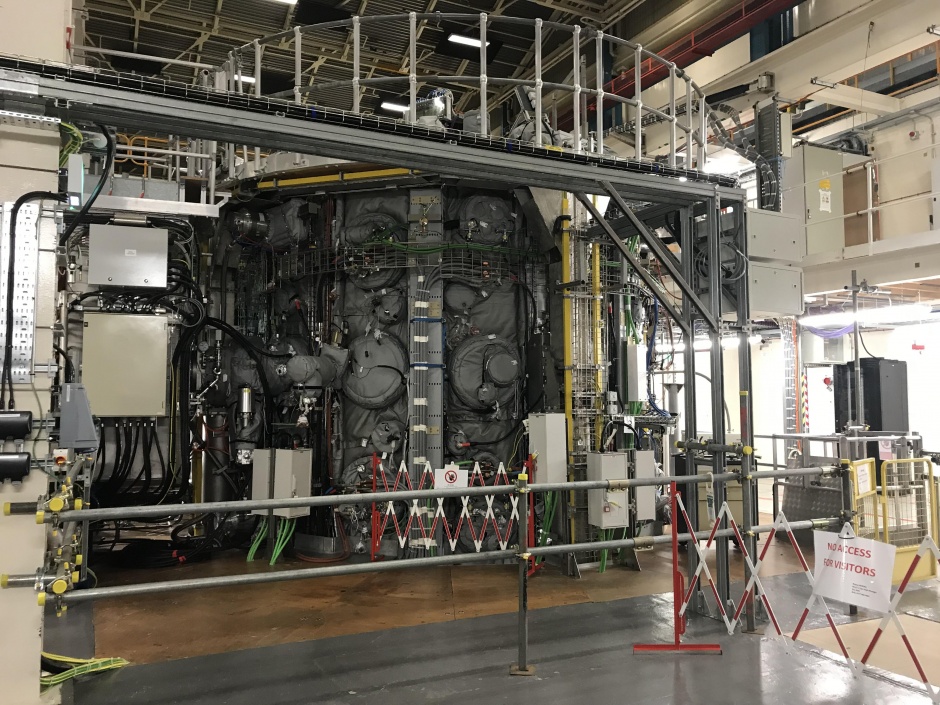
Currently, the engineering research towards DEMO is mainly directed towards two particular subsystems of importance to the electricity-generating fusion reactor: the diverter, where the fusion plasma comes into contact with the vessel, and the blanket, which generates tritium for the fusion fuel and houses the cooling circuits.
Three diverter technologies are currently under consideration. These are known as snowflake, liquid-metal and SUPER-X exhaust.
Both snowflake and SUPER-X exhaust spread the impact of the plasma over a wider area than that of the diverters used in tokamaks like JET and WEST, which formed the basis of the design that is being manufactured for ITER. Magnets called correction coils, around the base of the reactor vessel, shape the plasma so that it contacts both edges of a trench-shaped component. The energy load is huge: more than 10 MW per square metre, higher than a spacecraft re-entering Earth’s atmosphere.
In the snowflake diverter, a different arrangement of correction coils shape the plasma into a snowflake-like shape, which contacts a wider diverter at several points, each of which will therefore experience less thermal load than the trench-shape diverter. This, explained Eurofusion’s Tony Donné, will reduce wear on the diverter sections, and increase their lifetime, while also reducing the risk of particles scraped off the diverter contaminating the plasma. As each diverter segment is made out of large, solid forgings of tungsten, this will reduce the running costs of the reactor and also make maintenance more simple.
Snowflake diverters were first investigated at the Lawrence Livermore National laboratory in California. These experiments confirmed that heat load is reduced, the plasma is less contaminated by particles scraped off by the plasma impact and that “confinement” – the squeezing of the plasma to increase its density and increase the probability of fusion events – is unaffected. Further experiments with a snowflake diverter directed towards a DEMO-sized reactor vessel are scheduled to be carried out after an upgrade to an experimental tokamak in the Czech Republic within the next few years.
The SUPER-X exhaust similarly uses magnetic fields to spread out the impact plasma on the diverter, but rather than changing the shape of the impact zone, it increases the length of the path along which the plasma impacts the diverter. It resembles water spiralling down a conical drain. An ongoing upgrade to MAST at Culham will include the installation of correction coils which will allow different configurations of plasma exhaust to be created, and SUPER-X is one of those that will be tested. The upgrade is expected to be completed next year, and tests with the reconfigurable diverter will begin in 2020, ahead of an expected set of JET experiments using deuterium-tritium plasma which may break the current Q-factor record.
The liquid-metal concept is slightly different. The plasma is steered into a flowing “river” of molten metal. This means that any damage caused by the plasma impact would be instantly healed.
This is a new concept, devised at the Czech Academy of Sciences and at the IAEA research establishment in Vienna, and as-yet untested. Researchers believe that lithium, tin and gallium could be possible components of the liquid metal, and immersed electrodes will attract the plasma into the liquid and away from solid surfaces. A tokamak designed to test this technology is planned in Italy, but funding has not yet been confirmed (at the last review by EUROfusion, funding was delayed into the middle of the next decade).
Designs for blanket technologies are somewhat more advanced than those for diverters. Four candidate technologies are being developed for testing inside ITER: two in Europe, one in China and one in India. All the technologies take a different approach. Physics is helpfully agnostic: it doesn’t matter what form lithium is in; as long as a neutron can collide with a lithium atom, it will be transmuted into a tritium atom.
All the candidates use helium as a coolant. One of the two European technologies uses a liquid eutectic alloy of lithium and lead, while the other uses “pebbles” made of a ceramic containing both lithium and a compound containing beryllium and titanium: beryllium is useful because it has the property of multiplying neutrons.
The Chinese candidate technology is also a helium cooled system using solid pebbles, but the modules will contain two distinct pebble beds, one containing lithium silicate and the other containing a beryllium-rich ceramic. This technology may also be tested in a planned Chinese experimental tokamak, China Fusion Engineering Test Reactor (CFETR) which is usually described by the fusion community as being “DEMO-like” in configuration and whose construction is currently scheduled for the 2020s.
The Indian technology, called a lithium-lead ceramic breeder, uses both a lithium-lead liquid eutectic and a lithium-containing ceramic: the liquid metal cools the tritium breeding zone, and helium cools the plasma-facing wall of the blanket module. Originally developed in collaboration with Russian researchers, this technology is believed to have a high tritium breeding ratio and to enable efficient heat to electricity conversion.
Breeder blanket concepts are currently expected to will be tested fairly late in ITER’s experimental schedule, possibly even late in the 2020s or early 2030s.
Read about the other ways in which DEMO will differ from ITER




Red Bull makes hydrogen fuel cell play with AVL
Formula 1 is an anachronistic anomaly where its only cutting edge is in engine development. The rules prohibit any real innovation and there would be...